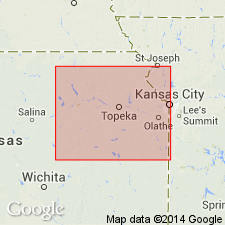
- Usage in publication:
-
- Buckeye shale
- Modifications:
-
- Original reference
Summary:
Pg. 12. Wellington shale (restricted) divided into (descending): (1) Carlton limestone (thin-bedded limestone, massive limestone, thin shale, and at base, conglomerate), 17+/- feet thick; (2) Buckeye shale, 45+/- feet thick.
[Origin of new names Carlton and Buckeye not stated.]
[GNC remark (US geologic names lexicon, USGS Bull. 896, p. 284): Buckeye shale of Sumner group. Recognized in northeastern Kansas. Age is Permian.]
Source: US geologic names lexicon (USGS Bull. 896, Carlton entry p. 349); GNC KS-NE Permian Corr. Chart, Oct. 1936.
- Usage in publication:
-
- Buckeye shale
- Modifications:
-
- Areal extent
Garlough, J.L., and Taylor, G.L., 1941, Hugoton gas field, Grant, Haskell, Morton, Stevens, and Seward Counties, Kansas, and Texas County, Oklahoma: American Association of Petroleum Geologists Special Volume, no. 11, p. 78-104.
Summary:
Pg. 87 (table 2). Buckeye shale. Table lists rocks of Sumner group at their outcrop, 200 miles east of Hugoton gas field; Wellington shale is divided into (ascending) Buckeye shale, Carlton limestone, shale, and Geuda salt. Age is Permian.
Source: US geologic names lexicon (USGS Bull. 1200, p. 512).
For more information, please contact Nancy Stamm, Geologic Names Committee Secretary.
Asterisk (*) indicates published by U.S. Geological Survey authors.
"No current usage" (†) implies that a name has been abandoned or has fallen into disuse. Former usage and, if known, replacement name given in parentheses ( ).
Slash (/) indicates name conflicts with nomenclatural guidelines (CSN, 1933; ACSN, 1961, 1970; NACSN, 1983, 2005, 2021). May be explained within brackets ([ ]).

